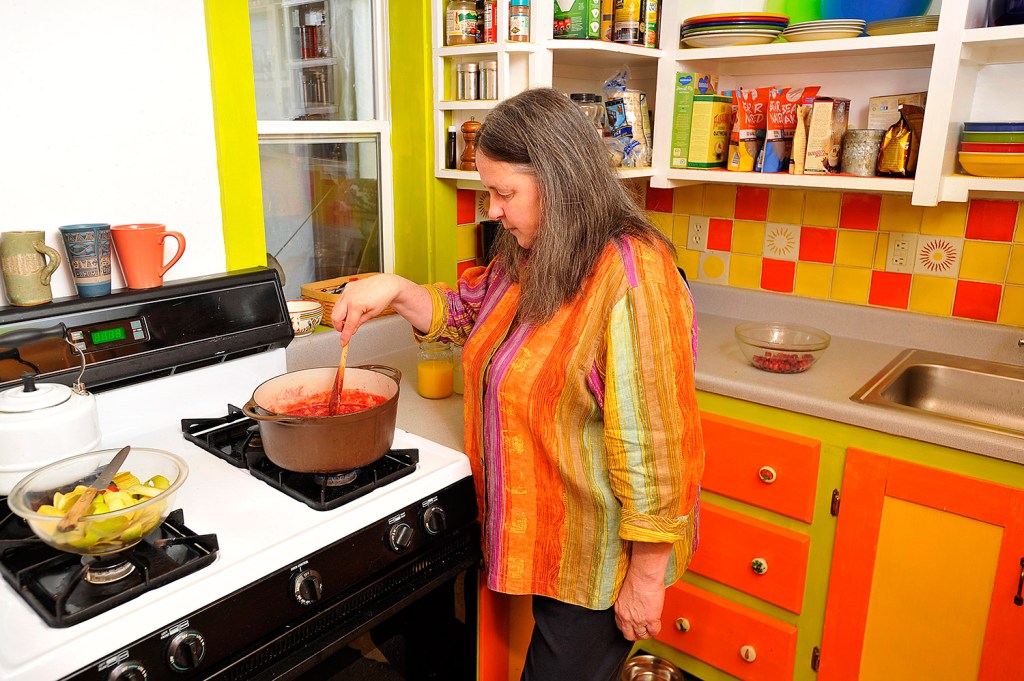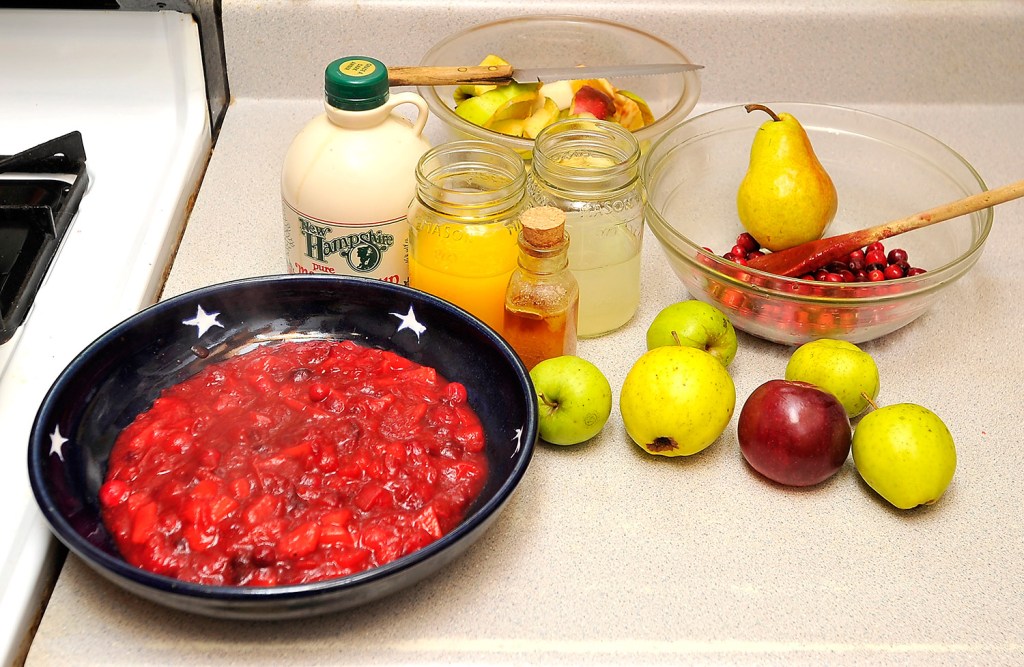Ellen Cooney has written an entire novel focused on the all-American holiday of Thanksgiving. A wild turkey shot dead in the first chapter and sold at a Boston market is practically a main character.
But in real life you will never catch Cooney in a steamy kitchen on turkey day, basting a bird or carving its breast. Next week, while others are swooning over the scent of roasting turkey wafting from the oven, Cooney will satisfy herself with homemade cranberry sauce, chestnut dressing and other traditional sides of the holiday meal. She describes herself as transitioning to vegetarianism.
“I would rather write about the turkey than eat it,” she admits.
Cooney, 62, lives in Phippsburg and is the author of nine novels and many short stories published in the New Yorker and various literary journals. Thanksgiving may not be Cooney’s favorite holiday, but you wouldn’t know it from reading her book “Thanksgiving,” which tracks the fortunes of a single family living in the same house in Massachusetts from 1662 through 2012. Each of the 22 chapters is named after part of the Thanksgiving meal – squash, yams, stuffing, gravy – and each chapter takes place on the same Thursday in late November.
In every chapter, the women of the Morley family are preparing or serving food. The men of the family are there, too, with their own stories and dreams, but it’s the women who are the heart of the 350-years-long storyline. Cooney says she wanted to write about women working with food over the course of centuries because she views their contributions as part of American history, as much as men going to war.
There is Patience, the first matriarch of the Morley family, whose hands grow strong like a man’s from carving so many pumpkins, who loses her spectacles in the creek during an Indian raid and who keeps a family secret about a wild turkey. There’s Ruth, who is attacked by her abusive husband in 1801 as the pot of cranberries cooking over the fire burns. And there’s Mary Pearl, whose brothers fought in Vietnam and who frets about getting into college while she prepares the green beans, creamed spinach and Brussels sprouts for Thanksgiving dinner.
“It’s about the work that women are doing in their houses, and why don’t we call that history?” Cooney said. “Why don’t we say what a woman was doing with vegetables in the 1800s is as much history as something that was going on politically, or some battle in a war?”
Yes, women’s history and food history are topics in university classrooms, but Cooney is talking about the rest of us who tend to think of the past in sweeping terms. For most of us, for example, the 19th century is synonymous with the Civil War, but can any of us explain in detail what our great-great grandmother’s daily life was like back then, when women were largely invisible because they were confined to the home?
Food is the thread that runs through Cooney’s book, tying the women’s stories together in multiple ways. There’s the food being prepared in each chapter, of course, but there’s also the perfection of family recipes over several decades and, on a broader level, the very idea of the Thanksgiving meal as a vehicle for bringing families together.
“What I feel about history so strongly is that it’s with us now,” Cooney said. “For example, there’s food in the past that turns up again in the present almost magically. Here’s a potato sitting on your counter for your Thanksgiving meal, but 200 years ago somebody else was peeling the potato. The past is with us all the time.”
The Morley family home is also a constant in the book. It expands, as does the nearby graveyard, as the family grows and the years pass.
Throughout the book, Cooney cleverly weaves the generations together using family stories and anecdotes. Minor spoiler: Patience Morley’s lost spectacles are found 200 years later by one of her descendants. And, unfolding through several chapters, we eventually learn the story of what really happened to the wild turkey in chapter one.
“Thanksgiving” is Cooney’s first ebook, using a local publisher called Publerati; it came out in 2013. After wrangling with traditional publishers, she called the decision “a no brainer.”
“There was a publisher, a big house, that was very interested in it, but the editor asked for changes that I could not do,” Cooney said. “They were fundamental changes in the structure and the outlook of the book to take the emphasis away from the history of women cooking in a kitchen. More than one editor said this, that women doing things with food is not historical fiction, so my book didn’t fit a category.”
But to Cooney, writing about Eliza Morley’s reluctance in 1726 to churn into butter the extra cream her son has brought her when she’d rather be sketching, is history.
“The top of the table is covered with buckets,” Cooney writes. “Every chair has a bucket on its seat. Under the table is a wide metal tub, and the tub is full of cream, and the buckets are full of cream, and of course, he’s not home. He must be expecting her to change the cream easily, wonderfully, like water into wine.”
Eliza grows weary just looking at all the cream, but she churns it anyway because she knows it will be good for the family.
Cooney’s favorite character in the book is Letty, a young woman in 1818 who longs to go to college but instead watches as her brothers get all the opportunity. Her other favorite is Emily, the uptight widow who, in 1927, cries into her perfect pie crust.
“Letty, I can relate to personally, but there are other characters in this book who are totally not me, and that’s my favorite kind of character to create,” Cooney said. “I just really had such an adventure getting into the heads of women like that.”
A native of Massachusetts, Cooney lived for many years in Boston and Cambridge, and has taught at Boston College, Northeastern University, Harvard and MIT. She started coming to Maine to get away from her hectic life in Massachusetts. Her wife, Ellen Winchester, built them a house in Phippsburg, “and it became home,” Cooney said. “I didn’t want to go back.”
The couple has a grown son who lives in California. They live with three dogs – Andy, a golden retriever descended from a long line of champions; Maxine, a lab/wire-haired terrier mix rescued from a shelter; and Skip, or Skippy, a Nova Scotia duck tolling retriever who was the inspiration for her latest novel, “The Mountaintop School For Dogs And Other Second Chances.”
The inspiration for “Thanksgiving” came from two sources – her interest in time travel, and the Thornton Wilder play “The Long Christmas Dinner,” which goes through 100 years’ worth of Christmas Days. Her own idea of time travel, she said, is not imagining herself in the past, but rather in someone else’s present.
“It’s not like looking over your shoulder,” she said. “It’s about looking straight on, like you’re already there. That’s what I did with ‘Thanksgiving.’ I imagined myself there.”
Like many of her characters in “Thanksgiving,” Cooney does all the cooking in her house. She loves to cook and says she learned how from her grandparents.
“I had the unusual gift of having two grandfathers who cooked, one Italian and one English, from Yorkshire,” she said. “My English grandfather, for example, made his own French fries. I could never eat French fries from McDonald’s because I knew what a real French fry tasted like. I was a very observant child, and I didn’t want to cook the way my mother did because hers was all based on cans and pre-made food.”
Women like her mother embraced processed foods such as cake mixes and potato flakes, Cooney believes, not just for convenience but because it made her, as the child of immigrants, feel like an American. Cooney’s own routine is to go to the market, see what’s fresh, then bring it home and decide how to prepare it. But …
“If I’m writing, if I’m more than at the halfway point of a novel,” she said, “we get a lot of takeout.”
Although the Thanksgiving turkey makes repeat appearances throughout Cooney’s book, she has stopped cooking the birds herself. Her specialty at the holiday? The sides, including cranberries.
Cooney grew up with canned cranberries and bought her first bag of fresh ones when she was in her 20s and on her own. She was terrified.
“It’s now my favorite thing to make for Thanksgiving,” she said. She makes it with apples from her own trees, putting about a pound and a half of Maine cranberries in a pot, covering them with orange juice and a little lemon juice, adding minced apples and pears, local maple syrup to taste and a little local honey.
“I stay with it, stirring like it’s a risotto, turning it to low after letting it come to one quick, frothy boil,” she said. “I keep aside about a half cup of cranberries to add post-boil to give it an uneven texture. I add more juice if it thickens too much. It’s done when most of the berries have popped.”
And where will she be serving her cranberry sauce this year? While Cooney and her wife often gather with family to celebrate, she admits she’s hoping they’ll be invited to a potluck this year.
“I have absolutely no idea what I’ll be doing this Thanksgiving,” she said.
Copy the Story LinkSend questions/comments to the editors.









Success. Please wait for the page to reload. If the page does not reload within 5 seconds, please refresh the page.
Enter your email and password to access comments.
Hi, to comment on stories you must . This profile is in addition to your subscription and website login.
Already have a commenting profile? .
Invalid username/password.
Please check your email to confirm and complete your registration.
Only subscribers are eligible to post comments. Please subscribe or login first for digital access. Here’s why.
Use the form below to reset your password. When you've submitted your account email, we will send an email with a reset code.